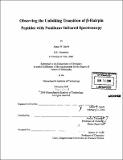| dc.contributor.advisor | Andrei Tokmakoff. | en_US |
| dc.contributor.author | Smith, Adam Wilcox, 1977- | en_US |
| dc.contributor.other | Massachusetts Institute of Technology. Dept. of Chemistry. | en_US |
| dc.date.accessioned | 2008-12-11T18:25:15Z | |
| dc.date.available | 2008-12-11T18:25:15Z | |
| dc.date.copyright | 2008 | en_US |
| dc.date.issued | 2008 | en_US |
| dc.identifier.uri | http://hdl.handle.net/1721.1/43772 | |
| dc.description | Thesis (Ph. D.)--Massachusetts Institute of Technology, Dept. of Chemistry, 2008. | en_US |
| dc.description | In title on t.p., "[beta]" appears as the Greek letter. Vita. | en_US |
| dc.description | Includes bibliographical references. | en_US |
| dc.description.abstract | The biological function of a protein is in large measure determined by its three-dimensional structure. To date, however, the transition of the protein between the native and non-native conformations is not well-understood. Part of the difficulty is the large conformational space available to a poly-peptide chain, and a general lack of experimental probes that can access local structural information on the time scale of the transition. Single domain peptides are excellent model systems that reduce the size and complexity of the problem, while maintaining the essential physical interactions. In this thesis, P-hairpin peptides are used as model systems for studying P-sheet secondary structure. Hairpin folding has been studied for a number of years, but there is still debate in the literature about the relative importance of the cross-strand hydrogen bonds, tertiary side chain contacts, and p-turn in the folding pathway. In addition, the denatured state is very poorly understood, which complicates any attempt to describe the folding pathway. In this work, amide I vibrational spectroscopy is used to resolve the secondary structure of P-hairpin peptides during thermal denaturation. Spectroscopic modeling is presented to describe the amide I band of 0-hairpins and relate it to structural features. Three spectroscopic methods are used to probe the amide I band: Fourier transform infrared (FTIR) spectroscopy, two-dimensional infrared (2D IR) spectroscopy, and dispersed vibrational echo (DVE) spectroscopy. 2D IR and DVE spectroscopy are 3rd order-nonlinear methods that interrogate the system with a series of ultrafast (100 fs) laser pulses. 2D IR spectra reveal vibrational couplings and measure spectral dynamics on a picosecond time scale. . | en_US |
| dc.description.abstract | (cont.) The 2D IR spectra of TZ2 and PG12 are used to identify 3sheet structure during thermal denaturation and to measure the amide I homogeneous line width changes with temperature. The transient folding of TZ2 and PG12 is also probed with 2D IR and DVE spectroscopy following a 10 to 20 OC temperature jump. In order to increase the structural sensitivity of amide I spectroscopy, 13C and 180 isotope labels are incorporated into specific peptide amide groups. The isotope labels red-shift vibrational frequencies and help resolve local structure at the turn and mid-strand regions of the peptides. The transient folding at each labeled site is also measured following a temperature jump. Together, the results of this work identify folding rates for the thermal disordering transition. For PG12, the unfolding time at the mid-strand region of the peptide is 130 ns, and the turn is found to be stable throughout the transition. For TZ2, the kinetic folding rates at each of the labeled sites are found to be very similar to the global unfolding time (-1 Its). Temperature jump 2D IR spectroscopy of TZ2 reveals that the disordering mechanism is unique for different regions of the peptide. The band corresponding to the turn region decouples from the other vibrations, but does not show signs of disorder. In the mid-strand region of the peptide, the isotope-shifted band decouples from the main amide I band and also broadens significantly. Local disordering and decoupling both occur on a 1 gis time scale. The observations in this work combined with previous measurements are used to describe the folding as a hybrid zipper. TZ2 folding is initiated with the formation of the P-turn, following which the tryptophan side chains form a compact, but non-native hydrophobic core. Next, the backbone native contacts are formed and finally the tryptophan side chain packing reaches the native configuration. | en_US |
| dc.description.statementofresponsibility | by Adam W. Smith. | en_US |
| dc.format.extent | 283 p. | en_US |
| dc.language.iso | eng | en_US |
| dc.publisher | Massachusetts Institute of Technology | en_US |
| dc.rights | M.I.T. theses are protected by
copyright. They may be viewed from this source for any purpose, but
reproduction or distribution in any format is prohibited without written
permission. See provided URL for inquiries about permission. | en_US |
| dc.rights.uri | http://dspace.mit.edu/handle/1721.1/7582 | en_US |
| dc.subject | Chemistry. | en_US |
| dc.title | Observing the unfolding transition of [beta]-hairpin peptides with nonlinear infrared spectroscopy | en_US |
| dc.type | Thesis | en_US |
| dc.description.degree | Ph.D. | en_US |
| dc.contributor.department | Massachusetts Institute of Technology. Department of Chemistry | |
| dc.identifier.oclc | 260413798 | en_US |
